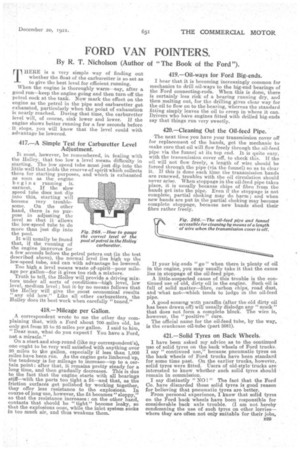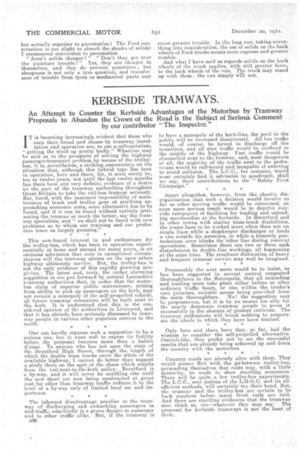FORD VAN POINTERS.
Page 27

Page 28

If you've noticed an error in this article please click here to report it so we can fix it.
By R. T. Nicholson (Author of "The Book of the Ford").
THERE is a very simple way of finding out whether the float of the carburetter is so set as to give the best level for efficient running. When the engine is thoroughly warm—say, after a good run—keep the engine going and then turn off the petrol cock at the tank. Now mark the effect on the engine as the petrol in the pipe and carburetter get exhausted, particularly when the point of exhaustion is nearly reached. During that time, the carburetter level will, of course, sink lower and lower. If the engine shows better running for a few seconds before it stops, you will know that the level could with advantage be lowered.
417.—A Simple Test for Carburetter Level . Adjustment.
It must, however, be remembered, in -lealing with the Holley, that too low a level rneans difficulty in starting. The low speed tube must just dip into the little well that holds the reserve of spirit which collects there for starting purposes, and which is exhausted as soon as the engine Ii egins running ir_ earnest. If the slow speed tube does not dip into this, starting will become very troublesome. On the other hand, there is no purpose in adjusting the level so that it allows the low-speed tube to do more than just dip into the pool.
It will usually be found that, if the running of the engine improves for a few seconds before the petrol peters out (in the test described above), the normal level lies high up the low-speed tube, and can with advantage be lowered. Too high a level means waste ofsspirit—poor mileage per gallon—for it gives too rich a mixture. Truth to tell, the Holley will provide a driving mixture under all torts of conditions—high level, low level, medium level ; but it-by no means follows that the Holley will give the imost economical results "any old how." Like all other carburetters, the Holley does its best work when carefully "tuned."
Fig. 268. —How to gauge the correct level of the pool of-petrol in the Holley carburetter.
418.—Mileage per Gallon.
A correspondent wrote to me the other day complaining that, with a Ford about 700 .miles old, he only got from 23 to 25 miles per gallon. I said to him, "Dear man, what do you expect ? You have a Ford, not a miracle."
On a start and stop round (like my correspondent's), one ought to be very well satisfied with anything over 20 miles to the gallon, especially if less than 1,000 miles have been run. As the engme gets limbered up, the tendency is for mileage to increase—up to a certain point: after that, it remains pretty steady. for a long time, and then gradually decreases. This is due to the fact that the engine starts with all bearings stiff—with the parts too tight a fit—and that, as the friction surfaces get polished by working .together, they offer less resistance to the explosions. In course of long use, however, the fit becomes" sloppy," so that the resistance increases : on the other hand, contacts that should be "tight" become leaky, so that the explosions ooze, while the inlet system sucks in too much air, and thus weakens them.
419.—Oil-ways for Ford Big-ends.
I hear that it is becoming increasingly common for mechanics to drill oil-ways to the big-end bearings of the Ford connecting-rods. When this is done, there is certainly less risk of a bearing running dry, and then melting out, for the drilling gives clear way for the oil to flow on to the bearing, whereas the standard fitting simply leaves the oil to creep in where it can. Drivers who have engines fitted with drilled big-ends say that things run very sweetly.
420.—Cleaning Out the Oil-feed Pipe.
The next time you have your transmission cover off for replacement of the bands, get the mechanic to make sure that oil will flow freely through the oil-feed pipe via the funnel at its top end. It is quite easy, with the transmission cover off, to check this. If the oil will not flow freely, a length of wire should be forced through the pipe (via the funnel) so as to clear it. If this is done each time the transmission bands are renewed, troubles with the oil circulation should never arise. When stoppage in the oil-feed pipe takes place, it is usually because chips of fibre from the bands get into the pipe. Even if the stoppage is not complete, partial choking may do harm ; and when new bands are put in the partial choking may become complete stoppage, because new bands shed their fibre rather freely.
If your big-ends " go " when there is plenty of oil in the engine, you may usually take it that the cause lies in stoppage of the oil-feed pipe. A little-suspected cause of this trouble it the continued use of old, dirty oil in the engine. Such oil is full of solid matter—fibre, carbon chips, road dust, and -what not—which tends to lodge in the oil-feed pipe. A good sousing with paraffin (after the old dirty oil has been drawn off) will usually dislodge any " muck " that does not form a complete block. The wire is, however, the " positive " cure. The official name for the oil-feed tube, by the way, is the crankcase oil-tube (part 3081).
421.—Solid Tyres on Back Wheels.
I have been asked my advice as to the continued use of solid tyres on the back wheels of Ford trucks. I say "continued use," because pneumatic tyres on the back wheels of Ford trucks have been standard for some time past. On the earlier trucks, however, solid tyres were fitted. Users of old-style trucks are interested to know whether such solid tyres should remain in commission.
I say distinctly "NO " The fact that the Ford Co. have discarded these solid tyres is good reason for believing that pneumatic tyres are better. From personal experience, I know that solid tyres on the Ford back wheels have been responsible for considerable back axle trouble. (I am not hereby condemning the use of such tyres on other lorries— where they are often not only suitable for their jobs, but actually snperior to pneumatics.) The Ford construction is too slight to absorb the shocks of solids I recommend conversion to pneumatics. "Aren't solids cheaper? " "Don't they get over the puncture trouble? " Yes, they are cheaper in themselves, and they do prevent punctures; but cheapness is not only a tyre question, and transference of trouble from tyres to mechanical parts may mean greater trouble. In the long run, taking everything into consideration, the use of solids on the back wheels of Ford trucks means more expense and greater trouble.
And what I have said as regards solids on the back wheels of the truck applies, with still greater force, to the back wheels of the van. The truck may stand up with them: the van simply will not.
































